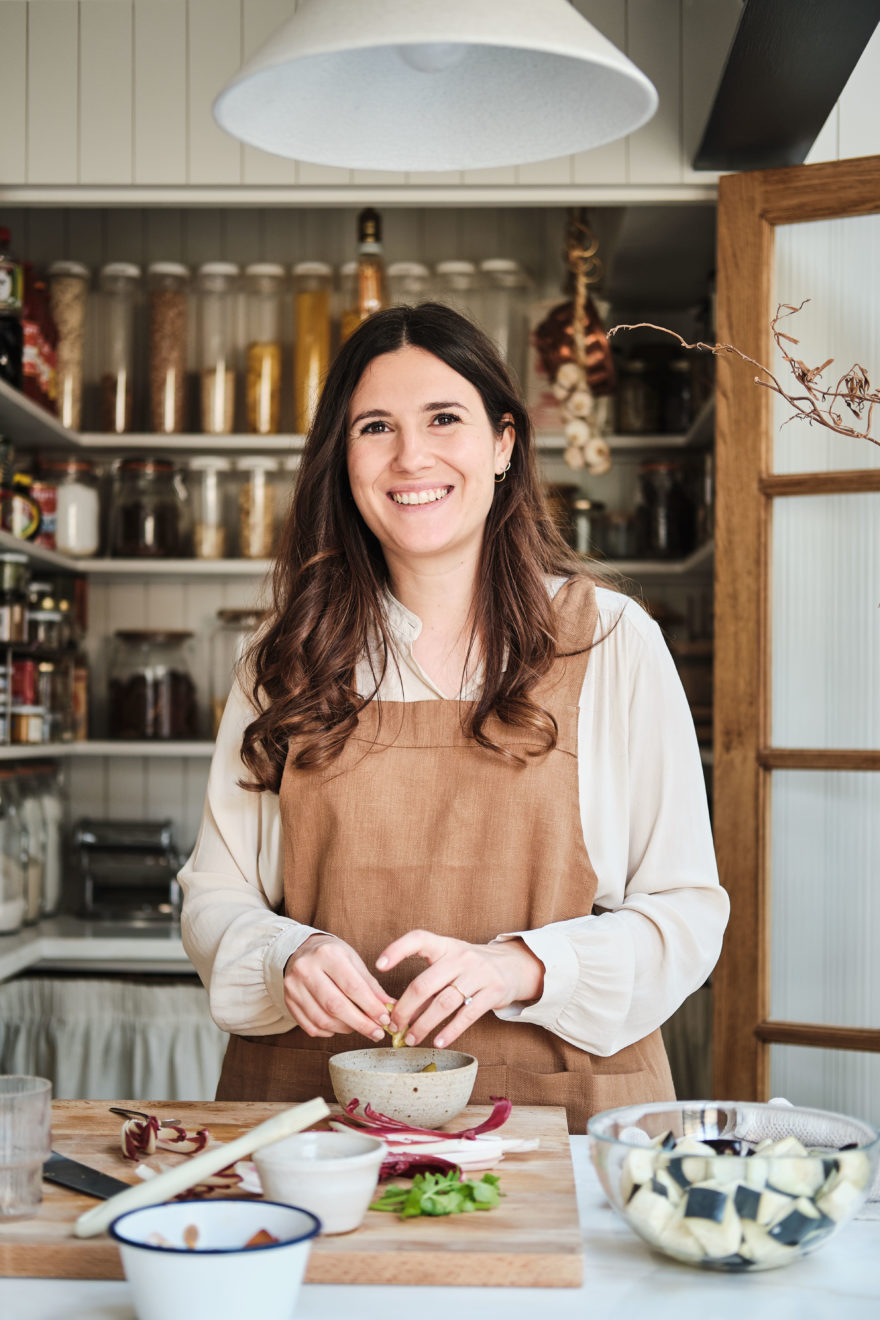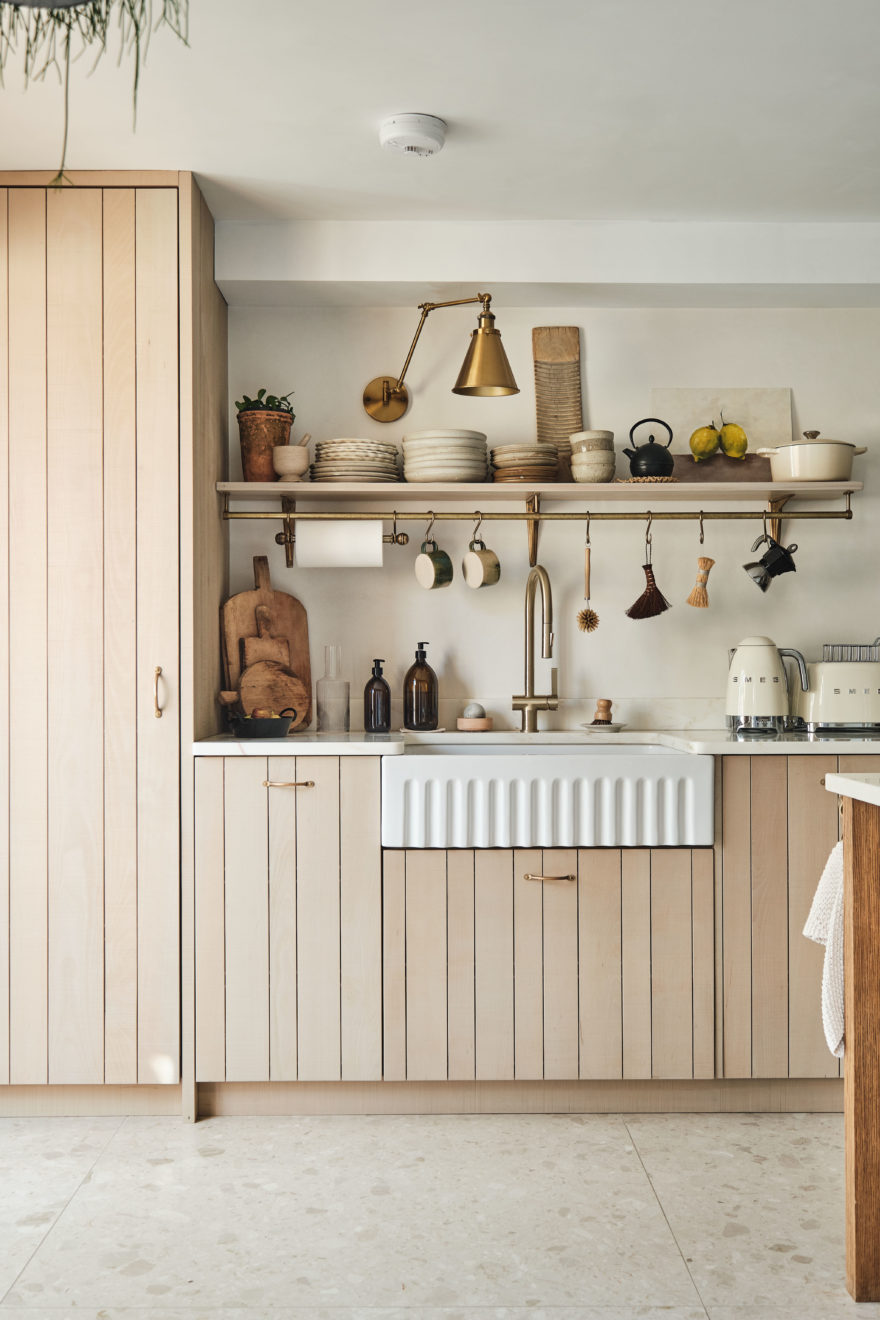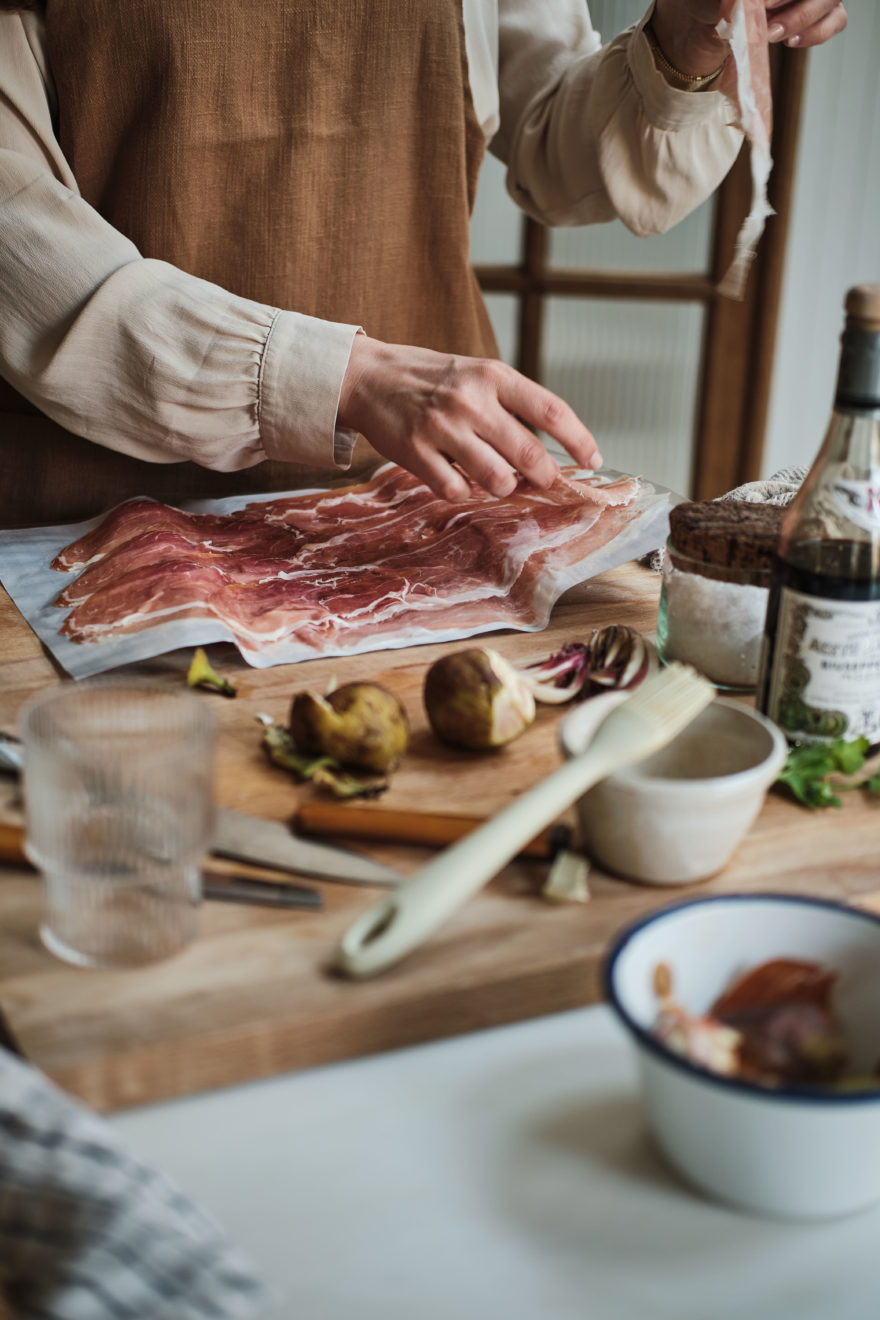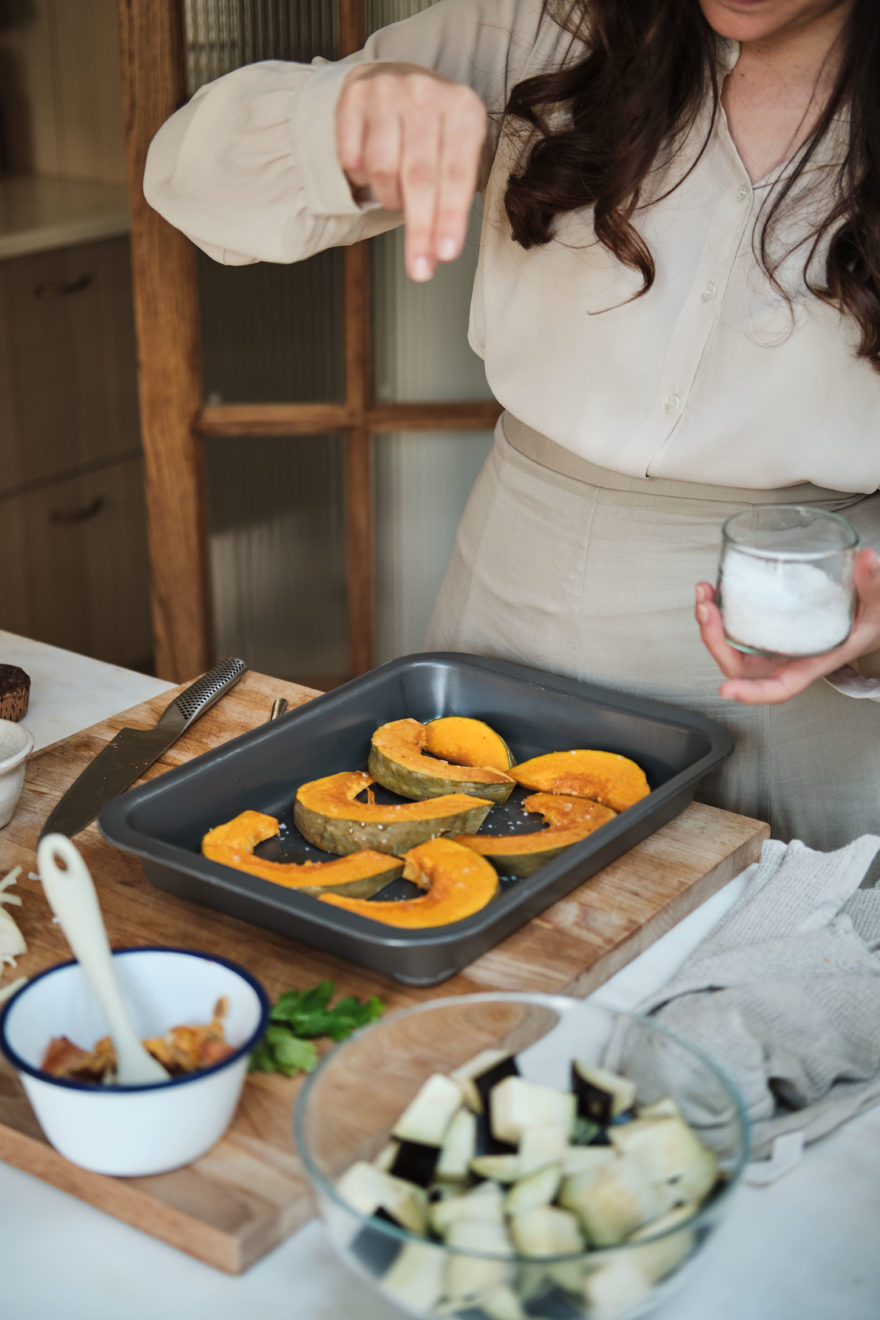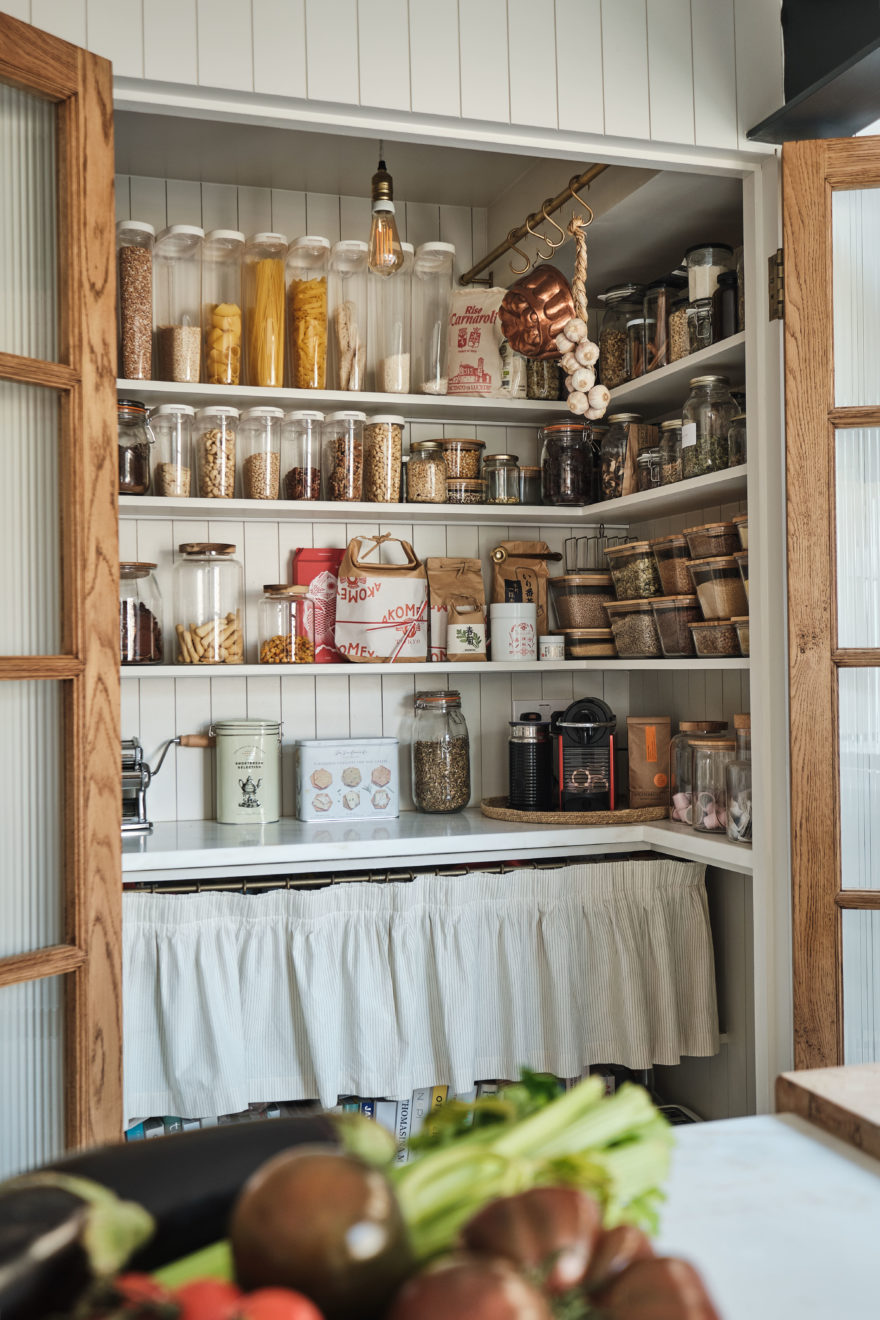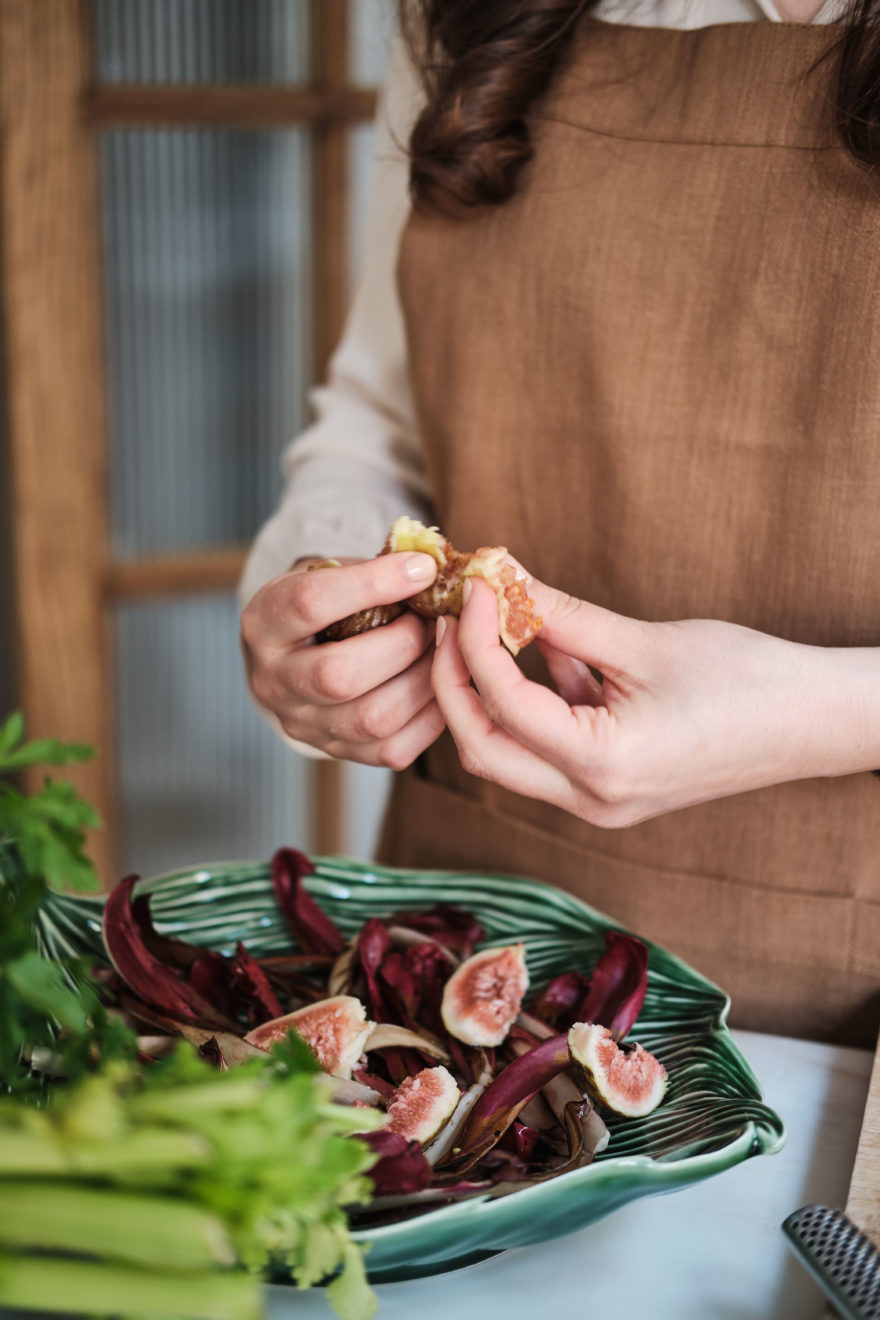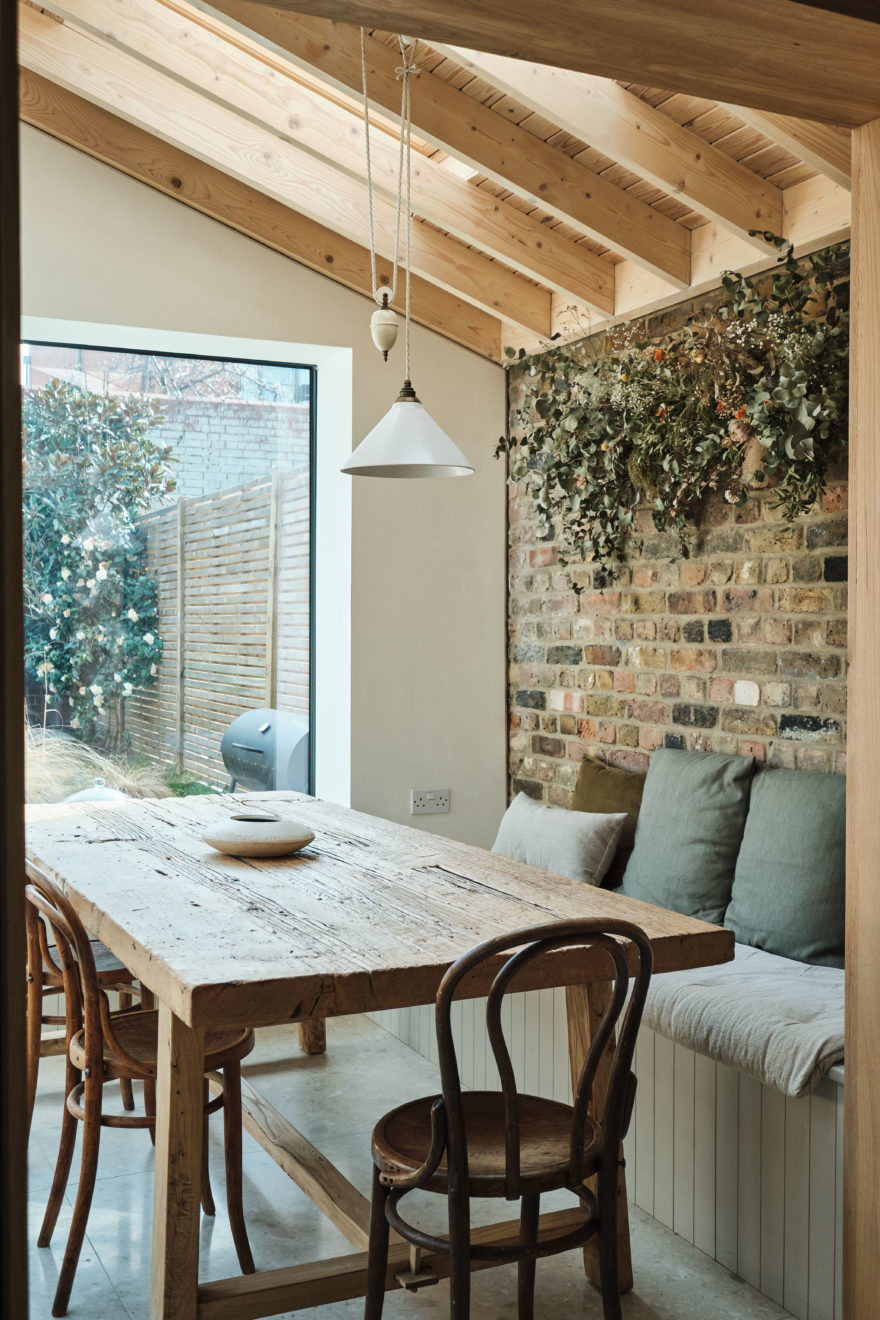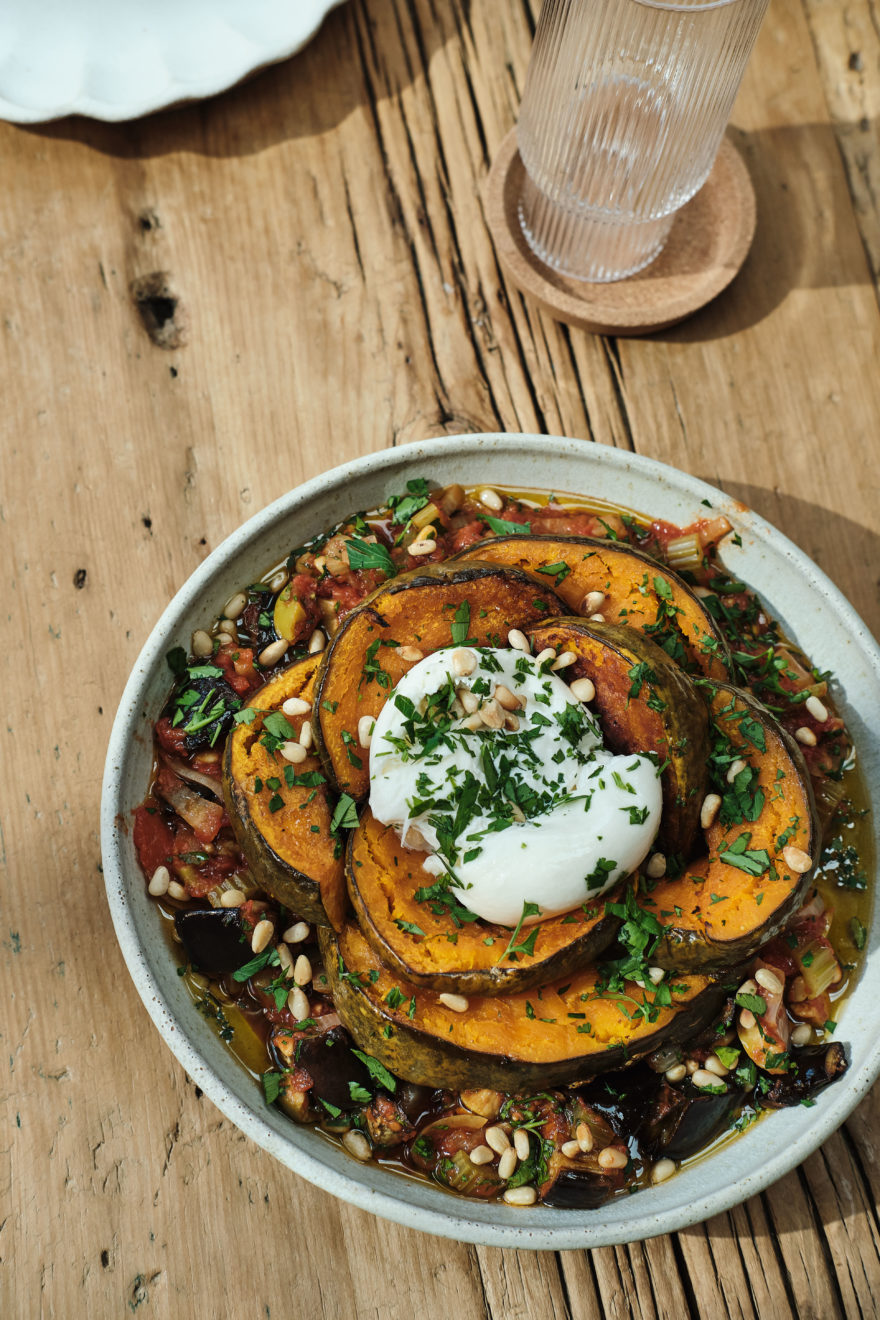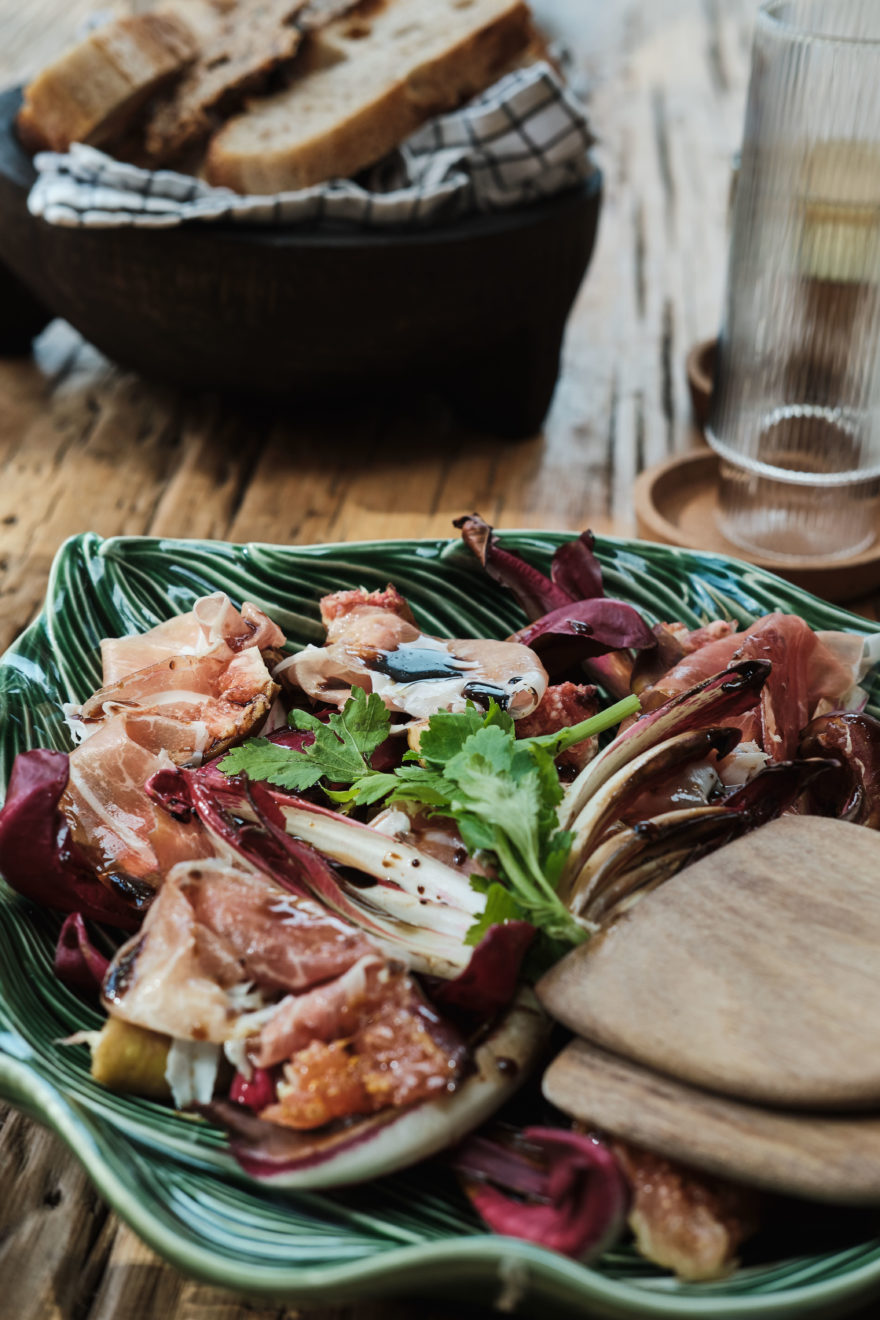The Venetian Pantry
Martina Casonato makes polymathy look easy. A graphic designer by trade, she draws on her Italian culinary heritage, photography expertise and design eye for her food and interiors-based Instagram presence, which has steadily grown in popularity since its inception in January 2021. The first post: the closed reeded doors of her ‘Venetian Pantry’, from which the account takes its name. It sits in the heart of Martina’s remodelled kitchen, which she designed herself, and which inspired her social journey – an expedition that is as authentic as it is aesthetic.
We visited Martina to begin our new series – Aucoot Eats – where we sit down to supper with food lovers, home cooks and professional chefs in their very own kitchens. We chat to Martina about her Italian heritage, her favourite food spots in London, what influenced her kitchen design and what inspires her cooking, all whilst she prepared us a delectable lunch of caponata with roasted delica pumpkin and burrata, served with a radicchio, prosciutto and fig salad.
I guess I always have had a passion for eating, but my passion for cooking only really developed in my twenties. My dad has always been the foodie of the family, so I guess I got my appetite from him. My mum, however, was never much into cooking, and although she does have one or two great dishes in her arsenal (and she makes fabulous jams!) growing up we mostly got by on simple meals and quite a lot of pre-frozen pasta (shocking coming from an Italian family, I know!).
It was only in my twenties, when I started living by myself, that I really developed my passion for cooking. My university tutor (and now dear friend) introduced me to Jamie Oliver and that was the initial spark. After I graduated from university with a Design bachelor, aged 22, I moved to London. Being exposed to so many different cuisines and incredible restaurants really cemented my love for food and helped develop my taste and expand my repertoire.
I see the kitchen as the true heart of a home, somewhere people gravitate towards and spend most of their time in. I like to have company while I cook – whether it is my partner or friends we are entertaining, so I designed the kitchen to be a sociable space.
Having a walk-in pantry has been a long-standing dream of mine, both from a functional but also an emotional point of view. Nothing gives me a sense of calm and abundance as the sight of a well-stocked pantry! That was the centrepiece around which everything else flowed. The placement of the island is a good example; we chose to have it perpendicular to the main kitchen runner instead of the more classic parallel configuration. A choice that to me was a no-brainer – it made total sense to have the main prep area in front of the pantry, but also being able to look outside onto the garden and the dining room and still engage with our guests.
I also had a long think about how I move around the kitchen and what would make my life easier, from the journeys I would need to take to lay or clear the table, empty the dishwasher and so forth. Storage was also a key component to figure out. One of my proudest achievements is our cutlery drawer, which I designed by laying out all our cutlery and utensils, measuring them and creating a grid to accommodate everything.
This is such a great question! It would have to be people who share a joy for food and cooking, I think. My first pick would be my great-grandmother Adele. I never met her but I have become very fascinated by her in recent years; she was a chef who owned her own Osteria, and she raised her three children by herself during the war. My grandma always used to speak very fondly of her, and by all accounts, she was an exceptional cook and all-round legend! I think she would get on like a house on fire with my second guest, Pellegrino Artusi – the father of modern Italian cuisine. His gastronomic treaty – Science in the Kitchen and the Art of Eating Well – was published in 1891 and it is still considered nowadays as the bible of Italian home-cooking. He lived through a very tumultuous time when Italy was still divided into separate reigns and was on the verge of being finally united, so I bet he would have some amazing stories to tell. And finally, I would add Jamie Oliver to the party. He loves Italian food, plus he seems like he would be a lot of fun to have around!
Oh gosh, I have really set myself up for a challenge with these guests haven’t I? Probably something simple and unpretentious; some homemade fresh pasta, a summer salad and tiramisù for dessert. You can never go wrong with these!
Simple by Ottolenghi – I adore his cooking style and this book is packed with inspiring and approachable recipes.
Science in the Kitchen and the Art of Eating Well by Artusi, if you want a deep dive into quintessential and traditional Italian cooking. I particularly love that at the end of the book, he has a list of suggested entertaining menus, two per each month. I should say banquets really, as each menu is seven courses long!
And, I can’t not mention 30 Minute Meals by Jamie Oliver – the first cookbook I have ever bought for myself, and one that will always have a special place in my heart!
I am a very spontaneous cook and I rarely follow a recipe – I tend to take inspiration from various places and improvise. Having said that, there are certain dishes I am drawn to time and time again – parmigiana and caponata being two of them (aubergines and tomatoes is a favourite combo of mine). In winter I love a good shortcrust pie with mash or roasted potatoes. I have now lived in England for a third of my life and I do feel it’s starting to rub off on me!
As my partner Joe knows well, I am a total sucker for a gadget, especially in the kitchen! By definition, none of them are essential really, but then again I am a big fan of things that make my life easier! The ones I tend to use the most are my Microplane grater and mandoline slicer. But the one thing I really couldn’t do without is my set of Japanese knives from Global. Sharp knives are a cook’s best friend!
When we bought the house, the kitchen was in its original Victorian configuration – a long and narrow galley kitchen with an equally long and narrow outdoor corridor to the left. We worked closely with George (one of the two partners at BVDS) to explore different layout options for the new kitchen. I was never a big fan of the open-plan style of extension and knew I wanted the space to feel dynamic, with different ‘pockets’ of action. Having a long external wall built on the boundary line with the neighbour created a long cone of shade on the old patio, but gave us the perfect opportunity to apply for an L-shaped extension, creating two distinct areas (the kitchen and dining room) that felt connected but separate at the same time. BVDS helped us with the structural side of the renovation, while I focused on the internal layout and design of the kitchen.
Here in Stokey we are really spoiled for choice when it comes to food. Our local greengrocer on Newington Green is one of the best in the area, and always has an amazing assortment of fresh fruit and veg, many of which come from Italy (I even found an obscure variety of radicchio from my hometown, Castelfranco!). A few metres down the road from there you have Gallo Nero, an authentic Italian deli I like to visit when I am feeling nostalgic. And, if we want to treat ourselves to gourmet ingredients, Yumi Cheese, Yield, Stokey Deli and Kitchen Provisions are my go-to places (the latter also sells an amazing variety of Japanese knives, if you are in the market for one!).
We are also incredibly lucky to have some of our favourite restaurants on our doorstep: Perilla, Jolene, Primeur and Aun being some of them. For a good Italian I would recommend Campania, on Columbia Road, Gloria in Shoreditch or Brutto in Farrington. I love the East London restaurant scene – it’s very experimental and vibrant, and there are always new exciting places to try out! Next on my list are Sessions Arts Club and Luca – I’ve been dying to try them for a while.
Without a doubt, the pantry. It is my pièce de resistance, the thing that most impresses our visitors and the focus point of the kitchen. I take a lot of pleasure in periodically re-stocking it, moving things around and re-organise it from time to time. I find it a very relaxing activity, a sort of meditation if you like!
Think long and hard about the gestures and the journeys you take when you cook and entertain. Take out everything you own and use in your current kitchen, lay it on the floor ahead of you and think about where each thing would go in your new plan. And, when it comes to materials, I am a big fan of letting natural materials shine. Colours go in and out of fashion, but there is a timeless quality about natural woods, stones and metals, that hopefully will serve you well for many many years.
Serves: 4
Prep time: 40 mins
Cooking time: 40 mins
Ingredients:
½ delica pumpkin
1 tsp smoked paprika
1 burrata
1 aubergine (large)
2 celery stalks
1 white onion
400 gr passata
40 gr capers, rinsed
60 gr green olives, pitted and halved
40 gr pine nuts, toasted
1 tbsp white wine vinegar
1 tbsp sugar
1 tbsp tomato concentrate
handful parsley, finely chopped
Method:
1. Preheat the oven to 180°C (fan). Slice the aubergine in half lengthways, then into 2cm chunks. Mix the chunks in a bowl with coarse sea salt and let them sweat for at least half an hour.
2. Leaving the skin on, cut the pumpkin into thick half moons (approx 2cm). Discard the seeds and lay the slices on a baking tray.
3. In a small bowl, mix the smoked paprika with 4 tbsp of olive oil. Brush half of the mixture onto the pumpkin slices.
4. Cook the pumpkin slices in the oven for approx. 30-40 mins, until both the skin and flesh of the pumpkin are soft. Take care to turn the slices mid-way through and brush again with the other half of the paprika-infused oil.
5. Cut the celery into 5mm slices. Parboil in water for 5 mins, then drain and set aside.
6. Rinse the aubergines thoroughly and pat them dry. Toss them in a bowl with an abundance of olive oil, then place on a roasting tray and cook in the oven until golden on the surface and soft inside (approx 20-30 mins).
7. Slice the onion and fry it lightly in a deep-sided pan (for which you have a lid) with a splash of olive oil. Reduce the heat to low and cover. Cook for 10 mins, until the onions become soft and translucent.
8. Add the celery, green olives, capers and passata to the pan. Let them cook together for 15 mins.
9. In a small bowl, mix the tomato concentrate, sugar and vinegar. Add the mixture to the pan and let it cook for another 5 mins.
10. Once the aubergines are ready, add them to the pan, along with half the toasted pine nuts and half the parsley. Stir well and leave to cool.
11. Caponata is best enjoyed tepid or cold, and tastes even better the day after! Serve with the roasted pumpkin slices and the fresh burrata on top, and garnish with a sprinkle of pine nuts and parsley.
Serves: 4
Prep time: 10
Cooking time: 2 mins
Ingredients:
1 radicchio rosso di Treviso
200 gr prosciutto crudo
6-8 figs
1 tbsp honey
1 tbsp balsamic vinegar
2 tbsp olive oil
100 gr walnuts
Method:
1. Wash and separate the radicchio leaves and lightly char them using a hot griddle pan.
2. Activate the walnuts by heating them up in a small pan, until slightly charred.
3. Prepare the balsamic vinaigrette by mixing the honey, balsamic vinegar, olive oil and salt and pepper.
4. Using your hands, gently tear the figs in halves (or quarters, depending on the size of the figs) and scatter them on top of the salad leaves. Do the same with the prosciutto (I love the Parma or San Daniele varieties, very thinly cut).
5. Pour the dressing freely on the salad and finish by crumbling the walnuts with your hands and scattering them on top.

